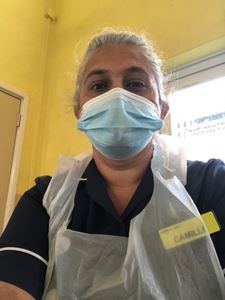Pandemic Times – a perspective from Dr Camille Cronin

We know COVID first emerged in Wuhan, China in late 2019, and from January 2020 we saw the first two cases appear in the UK. In March 2020, WHO declared a SAR-CoV-2 pandemic (WHO Director-General, 2020). Many of my nurse colleagues, alumina students and nursing students have been working on the frontline, facing COVID on a daily basis since. They have been learning and working together in a pandemic. which none of us have ever experienced in our lifetime. They have gowned up in PPE caring for those in need and caring for those fighting for their lives against COVID. The challenges on the front line in the acute hospital setting, primary care and long-term care settings have been tremendous with daily challenges to face each shift.

I have seen the healthcare workforce coming together, be it nurse, student, allied health care practitioner, doctor, pharmacist, porter, support staff or manager to make things happen. Despite huge workforce issues, massive change, resource constraints, sickness and death, these daily challenges in the healthcare workplace continue 24x7. Furthermore, it will be like this for the foreseeable future.
My role in the COVID pandemic has been through nurse education, clinical practice within primary care and the vaccine programme. These are important roles which form the backbone of healthcare. They played a vital role prior to Covid and will continue to play a vital role in the years of recovery ahead.
I work with my colleagues in Higher Education to continue to deliver an education programme for our future healthcare workforce, to maintain a stream of future practitioners. The challenges of online delivery, engaging our students in a vocational programmes, and maintaining placements in an ever-changing healthcare landscape has had its challenges but the resilience from both the teaching side of delivery and the students have been inspirational. All are committed to delivering healthcare that matters.

I have also contributed and played a role in primary care where care is fundamental in our local communities. Primary care is playing a part in the national workforce to vaccinate our country, together with vaccination centres which have now been formed. For me this has provided insight into our biggest national employer, the NHS working its wheels to engage a national workforce team to deliver a programme of vaccination to the UK population.

On the frontline I have seen the public, old and vulnerable, young and chronically ill, scared and thankful attending their appointments, gratefully receiving their vaccines. While it has only been a few months since the first days of starting up, setting rooms up, working with teams of volunteers, and seeing the long winding queues of our elderly and vulnerable cohorts’ queue, and using the first national COVID-19 Vaccination Scheduling and administration software. We do now have an organised well-oiled machine of vaccine delivery.
Over the Easter break I joined the vaccinating teams, with the nursing teams supported by teams of administrators and volunteers. Easter being a time of reflection and new growth I felt enthused by what I saw. We were concentrating on second Pfizer vaccines for those age 80 and over, and frontline health and social care workers. While meeting the old and young, the experience of public thanks was overwhelming. I met those whom I had vaccinated before and felt privileged to hear some of our 90 year+ elders recalling their experiences of the first “jab”, telling their stories of the “long lines of queues in the cold and rain”, their “year alone”, “not seeing loved ones or being with their grandchildren” and still with almighty strength all religiously isolating and wearing masks to keep safe and yet still able to welcome with open arms (not literally of course) and give thanks for their second vaccination. “Thank you, nurse you are doing a great job”.
